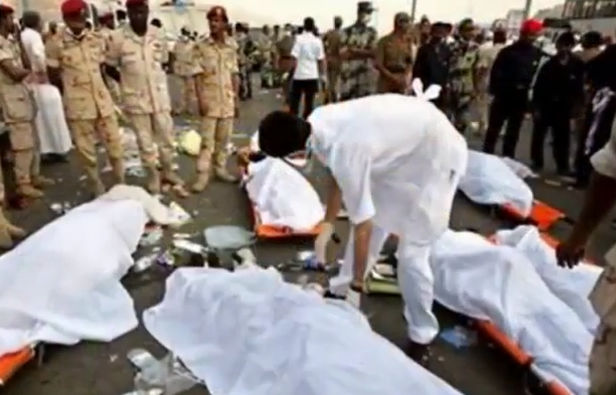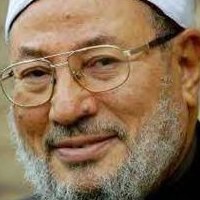![]()
Friday, September 25, 2015 | by R. Joseph Hoffmann
This article originally appeared after the stampede at Mecca in 2006. Yesterday, the news that over 700 pilgrims to Mecca died in a stampede, the worst in twenty five years, invites us to rethink religious zealotry, irrationality, the nature of religious violence and, of course, the devil.

According to news sources death toll in Mecca hajj stampede jumps to over 700 (Image still from youtube video — Al-Arabiyyah news channel)
Since September 11, 2001 literally dozens of books have appeared asking the question (many attempting to answer it) ‘Is Religion Violent?’ In particular the authors and commentators ranging from Bernard Lewis in What Went Wrong? to Mark Juergensmeyer in Terror in the Mind of God: The Global Rise of Religious Violence are asking whether the monotheistic religious traditions in general and Islam in particular are more prone to violence than, say, Buddhism, Shinto and Scientology. Almost all of these books — including one I recently edited, spaciously titled The Just War and Jihad[1] — answer the question with an unhelpful, “It depends on what you mean by violence,” as if September 11th were not instruction enough, or “What do you mean by “religious violence,” as if the men and women now known in the popular press and by the populace at large at “terrorists” were agnostic visitors from a distant planet, or perhaps a band of renegade Rotarians having a bad day.
We are enticed to see the events in New York, Indonesia, Madrid, and London, or the ongoing “insurgency” (read: unwon war) in Iraq, as the work of “extremists” — enemies of progress, or haters of modernity, or perhaps as heretics who stand outside the status quo of contemporary Islamic theology. At all events, we are asked to see their acts as Un-Islamic, the distaff of the way in which violent Muslims regard other Muslims — that is, as Un-Islamic. If there are parallels between this state of perpetual aspersion and other infra-religious hostilities — between once born and twice born Christian for example — they are imperfect, feeble even. Islam’s inability to decide what Islam is, who defines it, and how it relates to the world, the flesh and the devil is exquisitely contradictory and perfectly nonsensical. It has no real parallels in other religious traditions, and the parallels sometimes asserted to exist don’t. According to la pensée du jour the “terrorist” (Islamic fundamentalist, extremist) is a nonconformist who misunderstands the real meaning of the term jihad — a struggle not against people who don’t share your views (the argument runs) but an inner struggle for spiritual perfection. This opinion was canonized in 2002 when Harvard College bestowed the honor of delivering a commencement address on a certain Zayid Yasin, a former president of the Harvard Islamic Society, who expostulated thus:
“… Jihad, in its truest and purest form, the form to which all Muslims aspire, is the determination to do right, to do justice even against your own interests. It is an individual struggle for personal moral behavior.”
Especially today, it is a struggle that exists on many levels: self-purification and awareness, public service and social justice. On a global scale, it is a struggle involving people of all ages, colors, and creeds, for control of the Big Decisions: not only who controls what piece of land, but more importantly who gets medicine, who can eat. Jihad, performed rightly, is the same sort of activity one would expect of a Peace Corps volunteer or Médecins sans Frontières, only strangely different in its way of achieving humanitarian goals. But this sort of nicety — or naiveté — has a price. In the name of goodwill and universal sister/brotherhood, it is becoming harder for politicians and the press to see violence as something Islam needs to fix, and hence harder to fix blame, lest the protestations of an elusive and moderate “mainstream” begin to ring hollow–as in my view they already have. The argument for an essential or core goodness in religious traditions that have gone seriously askew or are seriously threatened is an old habit, indeed not so much an argument as a survival instinct, a reflex, in religion.
Christianity has been doing it for almost two millennia — since the time of Tertullian in the second century — Judaism for longer, at least since Nehemiah first slaked the thirst of the Persian king. In arguing that what the world is witnessing is an aberrational form of Jihad, moderate Islamic scholars and observers (whose views are widely detested by many other Islamic scholars and observers) are falling into line with what is now the catechetical tradition: a partitioning of Good Islam from Bad Muslims. Unfortunately, the textual tradition supporting the separation of Islam from its most vocal adherents is thin — so thin indeed that Daniel Pipes has written.
“It is bin Laden, Islamic Jihad, and the jihadists worldwide who define the term, not a covey of academic apologists. More importantly, the way the jihadists understand the term is in keeping with its usage through fourteen centuries of Islamic history. In pre-modern times, jihad meant mainly one thing among Sunni Muslims, then as now the Islamic majority. It meant the legal, compulsory, communal effort to expand the territories ruled by Muslims.”
It did not mean “inner struggle.” It meant violence in pursuit of religious and political goals. In order to understand the nature of violence in Islam, it’s useful to distinguish the forms it takes.
- Extrinsic Violence: Jihad and Aggression
Almost everyone in the west now knows the “extrinsic” form, violence directed by certain groups of Muslims against westerners (Crusaders), or their sympathizers, or those under a ban, like Salman Rushdie and Taslima Nasrin, declarations of war against the “Zionist entity” or “the great Satan Bush” and his minions.
The distinctions in motive between a suicide bomber on the streets of Tel Aviv or Baghdad and the organizers of the World Trade Center attack are comparatively minor save for numbers. Behind it all is a profound sense of alienation, reflected in the need to humiliate the offenders. The cultural “otherization” — the radical and humiliating derogation of a group based on racial or religious stereotyping — of which Edward Said accused the West in its understanding of the Middle East — cannot begin to match the otherization which the madrasa, the mosque, and the Islamic faculties of theology impose upon the west as a matter of educational correctness. And otherizing — the tendency to see what is uncommon in one’s own culture as a hateful menace to be dealt with as religion requires — is the chief source of extrinsic violence in Islam. It is a staple of the rhetoric of Al-Qaeda, Islamic Jihad, the Islamic Brotherhood in Egypt, of the newly legitimated Hamas in Palestine, and Hezbollah in Lebanon. It is not a minority view but a view which attracts thousands of the faithful, many of them young, only some of them poor or uneducated, and most of them angry, to choose struggle — the unnuanced form of jihad — and homicide bombings and various other lethal strategies as the highest form of virtuous activity.
The causes of extrinsic violence seem fairly simple to itemize: while George W. Bush appears to think it all has something to do with “hating freedom” and jealousy of the West in the Islamic world, it is apparent in bin Laden’s famous 1998 fatwa against the west, that the source of hostility is an inculturated suspicion of what Americans mean by freedom, what America does with freedom, and the way in which the United States and its allies conspire to spread their brand of freedom throughout the region, “All these crimes and sins committed by the Americans are a clear declaration of war on God, his messenger, and Muslims. … Nothing is more sacred than belief except repulsing an enemy who is attacking religion and life.” If the case bin Laden outlines in the fatwa had been framed in the 13th century, it would have been seen as the a solid case of the jus ad bellum, a call to a just war based on the violation of religious and territorial sovereignty. In fact a comparison of Pope Urban II’s language in his 1095 “fatwa” against the Muslims in his Deus vult! (God wills it!) with bin Laden’s language yields interesting information about causes and mindsets. Extrinsic violence in Islam is not arbitrary. It is logical, targeted, and spiritually significant. It has its price — the possibility of death — but also its rewards, the promise of the martyr’s crown:
“Almighty God said ‘O ye who believe, give your response to God and His Apostle, when He calleth you to that which will give you life. And know that God cometh between a man and his heart, and that it is He to whom ye shall all be gathered.”
The words might come from a Christian bishop of the 12th century; in fact they come from bin Laden himself, reminding the ummah that martyrdom is not optional when faith is threatened. And the concept of ummah, like the concept of jihad itself, is tied to the most emotive of Islamic concepts — that of individual duty: fard’ayn. I submit that no surviving religious dogma in the west — not the trinity, not the divinity of Jesus, not even the saving power of God, has the solidifying and militating power of the term ummat al-mu’minin — togetherness, unity. Perhaps the word “Catholic” once had this solidifying power, though its import seemed to hinge more on global extent of doctrine and authority than on a natural oneness. In any event, extrinsic violence is the natural consequence of this emotional appeal to unity and natural relationship. Some will say this sounds like an equivocal endorsement of Islamic violence, or an excuse for sin in the name of understanding. Rather, it’s an attempt to suggest why the view that Islam is a peaceful religion, “except for a few extremists…” is jejune and analytically impoverished, and why politicians and commentators must adjust their view before they frame their policies.
- Intrinsic Violence: Ritual and Obligation
Historically, Islam has experienced respites from violence: When it has been permitted rest from the challenges of foreign economic and political dogma, or when it has felt secure in its geographical dominion over the prophet’s lands, the dar al islam and when it has been able to trade and deal as an equal partner with nations that do not flaunt the superiority of unbridled secular modernity over the cultural backwardness of the Arab world. These “Whens” have been few and far between, penetrated since the 18th century by first an opulent Ottoman then European hegemony over the region, then by incursions as unanticipated as the creation of the state of Israel (“A Land Without People for a People Without Land”) to the impersonal assaults of western music, satellite television, pornography, and above all, the internet. It is the infracultural, often interpersonal conflict — not eo ipso a culture war — between wanting more and feeling that having more, especially more of the wrong thing, is sinful that explains a self-directed anger that can only be directed outward — at the other, and the other is always the Devil to be destroyed.
It is spiritual dissonance. And it is this spiritual dissonance that leads to the dichotomous approach to the world: an all-wrong West, a once-pure Islam, locked in an ongoing battle of cosmic proportions and enormous consequences. Christians have not thought this way since St Paul’s day (try 2 Corinthians 10:3-5), and thus hardly understand the stakes. The stakes are not merely political. They are eschatological.
But to understand extrinsic violence, one needs also to be aware of another sort of violence in Islam, one which poses no threat at all to westerners and unbelievers but which helps to explicate the other form. Intrinsic violence in Islam is a ritual occurrence. In 1990 over 1400 pilgrims making the obligatory hajj to Mecca were killed. In 2006, despite the Saudi government’s efforts to deal with the millions who make their way to Mecca, maintain the tourist base, and divert world attention from the perennial tragedy that is pilgrimage, 345 pilgrims met their death in the so-called “stoning ritual” on the last day of hajj.
Forty-thousand security forces stood by helplessly. The son of an American Muslim participating in the ritual was reported to say, “If one person trips, the push from the crowd behind will cause the people to either trample over the guy or fall down and be trampled by others.”
The urgency of completing the ritual is accompanied by unimaginable tension — a fear of failure, of not “doing things properly.” Abdullah Pulig, an Indian street-cleaner, told the BBC, “I saw people moving and suddenly I heard crying, shouting, wailing. I looked around and people were piling on each other. They started pulling dead people from the crowd,” and Suad Abu Hamada, an Egyptian pilgrim, told the agency he heard screaming and “saw people jumping over each other”. The narrow bottle-neck leading to the al Jamar-at has been called “the road of death” because of the hundreds who have died there. The pilgrims were returning from the via Mina after performing the Tawaf al-Wada, a farewell ceremony that involves walking around the Kaaba — a cube-like building in the centre of Mecca’s Great Mosque — seven times. The stoning ritual (rami) is the riskiest portion of the Hajj: in a narrowing passage, all the pilgrims must pass a series of three “pillars” (actually the remains of walls) called al-Jamarat representing the devil (more precisely where Satan tempted Abraham to renege on the sacrifice of his son) and which the faithful pelt with stones to purge themselves of sin.
As worshippers jostle to try to target the stones, weaker pilgrims fall under foot. The loss of life, while tragic, perhaps even preventable, and certainly violent, is ambiguous. Press reports of the violence naturally focus on the human toll, consequences, leaving the global audience puzzled about the causes and the Muslim perception of recurrent tragedy. Assessments of the catastrophe range from blaming the Saudi government for its inability to control the crowds, to blaming overzealous pilgrims for the spiritual gluttony that leads them to trample fellow pilgrims in the interest of a higher duty: “This was fate destined by God,” a pilgrim by the name of al-Turki is reported by the AP to have said. And Sobac Retok, in a letter to the BBC, “Everyone dies eventually. To be taken when ones faith is strong is an honour.”
“Look at it this way,” wrote Mohammad Malik, a German pilgrim: “Allah has taken your brethren at the most majestic moments in life, almost a blessing.” Hundreds of “verdicts” include the suggestion that the death of almost four hundred people was a triumph of faith, a martyr’s fate. Just as a faded sense of cosmic eschatology makes it hard for the westerner to understand the deeper sources of extrinsic violence, the intrinsic violence of the ‘rami is something pilgrims to the Vatican or Salt Lake City will have difficulty comprehending. Even the martyrdom cults of Christian antiquity provide little instruction, since the sacrifice of a Perpetua or a Stephen was intentional, not accidental — just as Christian martyrdom, as far as we know, and self righteous as it may have been, was a private choice, not a militant action designed to do as much damage to your enemies as possible. But there is a link between the two forms of violence in Islam. It is a link that western religions recognize but have never made the centerpiece of their doctrine.
In its core myth, Christianity pays lip service to a greatly enfeebled Satan. Once Lord of this World, he is consigned (as in the mythology whence he came) to the nether regions where his ability to do harm is minimal. It is an eccentricity of the Christian myth (as René Girard saw) that the practical, bloody violence is done to the Son of God as a declaration that violence has had its day. But even that violence, the violence of the cross and death itself — always associated with the devil’s prerogatives — is thought to be undone in the resurrection. Death (evil) Paul says has lost its sting; the grave has lost its victory. Christianity for all its wars and errors imagined its God as forsaking violence and incapacitating evil through a stratagem. It imagined its savior as becoming — to use the theological vocabulary — the victim of the violence (“the lamb of God”) which was merited by others. The cosmic eschatology of Christianity saw evil, sin and death as mystically defeated; and insofar as they still had power, it was because people were still, as a matter of will or choice, individually capable of violence against God — sin. Islam however in its theological eclecticism disliked myth and possessed only such ritual as expressed the believer’s subordination to the will of God. Muhammad, when he acted, acted in this God’s name.
The ummah, when it acts, acts in this God’s name, and often violently because it lacks the restraining power of a mythic figure and the mimetic feature which sees God as needing no helpers. Indeed, if it is a cardinal belief of Christianity and Judaism that God needs no help, then it is the feature that most distinguishes Islam from the other Book Religions that the Prophet’s God sees a failure to help, to be less than the Ansar al-Islam as shirk. And just as Islam rejected the belief that Jesus died violently on the cross (Surah 4:156-159), Satan remains to be subdued, whether in the form of three stone pillars or in the form of an unbelieving Modernity that rejects Allah and loves evil. The rationalized form of violence in Christianity — its myth of a crucified God and a subdued devil — created social mechanisms for coping with (ameliorating, Girard would say) injustice, deceit, viciousness — sin. The Koran does not understand evil as something that happened once upon a time, something to be dealt with by a savior. After all, the concept of “savior” is to “prophet” what liberation is to declaration. Both extrinsic and intrinsic violence in Islam derive from its core mythology of a God who asks more than “faith” in the power of the savior to save. Far from being able to appeal to a traditional record, a core myth, a Good Islam that transcends the Bad Muslims who act violently in the name of God, the mythology of Islam is being created day by day.
R. Joseph Hoffmann graduated from Harvard Divinity School and the University of Oxford (Ancient Near Eastern Studies). Hoffmann was tutor in Greek at Keble College and Senior Scholar at St Cross College, Oxford, and Wissenschaftlicher Assistent in Patristics and Classical Studies at the University of Heidelberg. He taught at universities in the United States, Britain and Lebanon. He has held visiting positions at universities in Africa, the Middle East, the Pacific and South Asia. He is now Professor of Liberal Arts at the American University of Central Asia. Beyond academe, he is well known for his advocacy of the humanist tradition. In his recent work, Hoffmann has turned increasingly to the work of ”humanist restoration”. His most recent books include an edited volume entitled Just War and Jihad: Violence in Judaism, Christianity and Islam (2006) and Sources of the Jesus Tradition (2010.) His study of the concept of the right to life in early Christianity, Faith and Foeticide, will be published in 2015, along with another in his series of translations of the classical philosophical critiques of the Christian movement: Christianity: The Minor Critics. He blogs at The New Oxonian. Read his full biography here. For all the exclusive blog entries by R. Joseph Hoffmann, go here.
Note:
[1] The Just War and Jihad: Violence in the Monotheistic Traditions (Amherst: Prometheus, 2006). — See more at: When the devil still matters.



 RSS
RSS










Latest Comments
Hello Mike, Thank you for your positive feedback to the article. I felt there wasn’t too much critical analysis of ...
Thanks for this considered and well constructed article. A follow up article on the manner in which the editorial contro...
THE CLUELESSNESS OF CLAIMING THAT OBAMA'S MIDDLE EAST POLICIES WERE A FAILURE CANNOT BE FURTHER FROM THE TRUTH, WHAT THE...
As long as Obama is the president of the usa do not trust the us government......
Thank you for an good read....